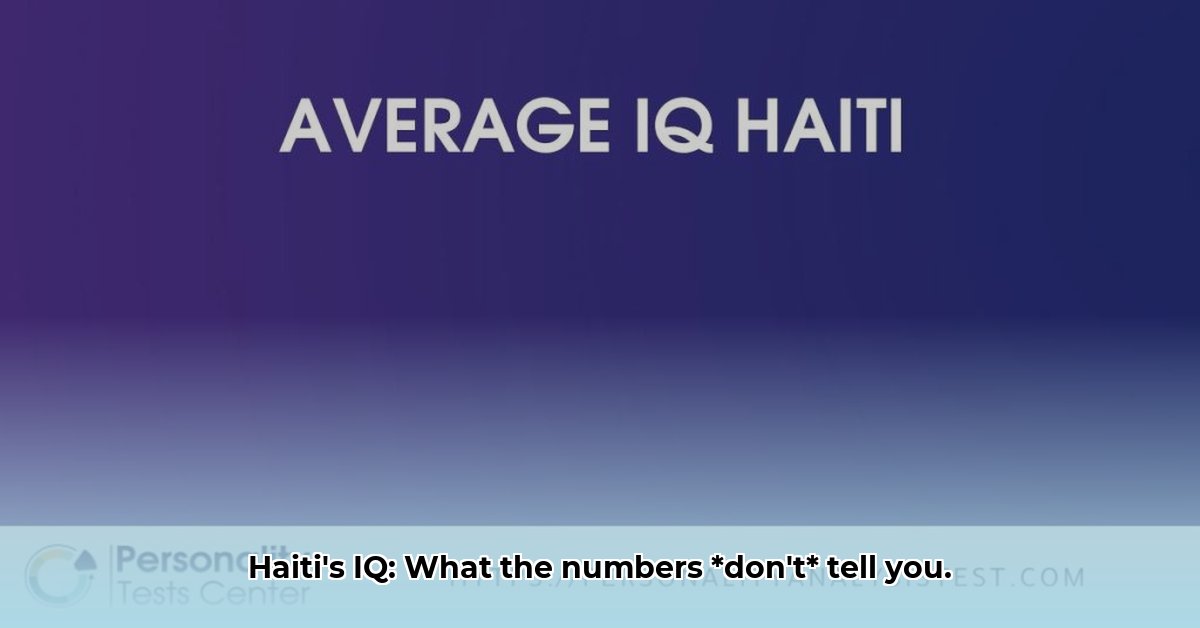Beyond a Single Number: Understanding Cognitive Development in Haiti
The notion of a single, definitive IQ score for an entire nation, especially one facing complex challenges like Haiti, is inherently flawed. While you might encounter figures online claiming to represent Haiti’s average IQ, these numbers often lack rigorous scientific backing and fail to capture the intricate interplay of factors that shape cognitive development. This article delves into the nuances of this complex issue, moving beyond simplistic metrics to explore the real factors influencing cognitive potential in Haiti.
Debunking the Myth of a Fixed IQ: Context Matters
The frequently cited figure of 67, often attributed to Haiti’s average IQ, stems from outdated and methodologically flawed research. This number not only misrepresents the reality of cognitive abilities within the country but also perpetuates harmful stereotypes. More recent studies suggest a range of scores, highlighting the difficulty of pinning down a single representative number. However, even these studies often suffer from limitations, such as small sample sizes and the use of tests that may not be culturally appropriate.
One of the most critical factors often overlooked in discussions about IQ is the profound impact of socioeconomic context. Imagine trying to concentrate on a complex problem while struggling with hunger, attending an under-resourced school, or living in a community grappling with instability. These are the daily realities for many Haitians, and they significantly influence cognitive development and performance on standardized tests.
- Poverty’s Grip: Poverty creates a cascade of challenges, limiting access to nutritious food, quality healthcare, and educational opportunities. These fundamental necessities are the building blocks of cognitive growth, and their absence creates significant barriers.
- Education’s Uneven Terrain: Haiti’s educational system faces numerous obstacles, including a shortage of qualified teachers, inadequate facilities, and disruptions caused by political instability and natural disasters. This uneven landscape makes it challenging to provide children with the consistent, high-quality education they need to thrive.
- Health’s Hidden Hand: Malnutrition, particularly in early childhood, can have long-lasting effects on brain development. Limited access to healthcare exacerbates this issue, allowing illnesses to go untreated and further hindering a child’s potential.
- Regional Disparities: Access to resources and opportunities varies considerably within Haiti, with urban areas often showing slightly higher average IQ scores compared to rural regions. This underscores the significant role of location and access in shaping cognitive development and educational outcomes.
To accurately understand cognitive potential in Haiti, we must move beyond simplistic IQ scores and consider the multifaceted realities of the country’s socioeconomic landscape.
Beyond IQ: A Holistic View of Intelligence
Traditional IQ tests, often developed in Westernized contexts, may not accurately assess cognitive abilities in culturally diverse populations. These tests can reflect cultural biases and fail to capture the full range of cognitive skills, such as problem-solving, creativity, adaptability, and emotional intelligence – skills crucial for navigating the complexities of life. Furthermore, the Flynn Effect, the observed trend of rising IQ scores over time globally, suggests that older studies likely underestimate current cognitive abilities. This makes comparisons across decades problematic and highlights the need for up-to-date research.
Investing in Haiti’s Future: Addressing the Root Causes
Focusing solely on IQ scores distracts from the real work: addressing the underlying factors that hinder cognitive development in Haiti. Instead of chasing a potentially misleading number, efforts should concentrate on tackling poverty, improving access to quality education and healthcare, and fostering a stable and supportive environment where children can flourish.
- Empowering Education: Investing in quality education, including well-trained teachers, adequate resources, and a stable learning environment, is crucial for unlocking Haiti’s human potential.
- Nurturing Health: Improving access to healthcare, particularly for children, and addressing issues like malnutrition are essential for supporting healthy cognitive development.
- Breaking the Cycle of Poverty: Implementing programs that address poverty’s root causes, such as economic development initiatives and social safety nets, can create a more equitable foundation for children to thrive.
Organizations like the World Bank (https://www.worldbank.org/en/country/haiti) and UNICEF (https://www.unicef.org/haiti/) offer valuable data and insights into the challenges and opportunities facing Haiti. By exploring their work and supporting organizations dedicated to sustainable development in Haiti, we can contribute to a more nuanced understanding and a brighter future for the nation.
Exploring Haiti’s Educational Landscape: A Multifaceted Challenge
Haiti’s educational system is a reflection of the nation’s complex socioeconomic realities. While access to education has improved in recent years, significant challenges remain. Understanding these challenges requires a holistic perspective that considers factors beyond the classroom walls. Some of these include:
- Socioeconomic Disparities: Poverty remains a major barrier to educational access and success. Children from impoverished families often face challenges such as malnutrition, lack of access to learning materials, and the need to work to support their families, hindering their ability to fully participate in education.
- Infrastructure Limitations: Many schools in Haiti lack basic infrastructure, including adequate classrooms, libraries, and sanitation facilities. This can create a challenging learning environment and limit the quality of education provided.
- Teacher Shortages and Training: Haiti faces a shortage of qualified teachers, particularly in rural areas. Furthermore, existing teachers often lack access to professional development opportunities, impacting the quality of instruction.
- Curriculum and Language Barriers: The language of instruction in Haitian schools is often French, while the majority of the population speaks Haitian Creole. This language barrier can create difficulties for students, especially in early grades. Furthermore, the curriculum may not always be relevant to the needs of Haitian students or aligned with local cultural contexts.
- Political Instability and Natural Disasters: Haiti has experienced periods of political instability and is vulnerable to natural disasters, both of which can disrupt education. School closures, damage to infrastructure, and displacement of populations can have long-lasting impacts on children’s education.
Understanding these challenges is crucial for developing effective strategies to improve education in Haiti. Moving forward requires a multi-faceted approach that addresses both the immediate needs and the underlying systemic issues. This includes investing in infrastructure, teacher training, curriculum development, and social programs that support vulnerable families. By working collaboratively with Haitian communities and organizations, we can help create a more equitable and sustainable education system that empowers all children to reach their full potential.
- Water Mill Electricity Generator Provides Free Home Power - December 16, 2025
- Water Wheel Electric Generator Provides Free Home Electricity - December 15, 2025
- Choosing the Right Portable Hydro Turbine for Your Needs - December 14, 2025
















